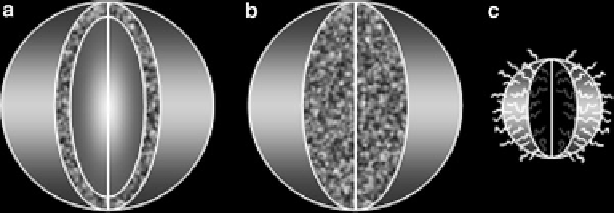Biomedical Engineering Reference
In-Depth Information
Fig. 1
Scheme of the different types of nanoparticles including nanocapsules (
a
), nanospheres
(
b
) and polymer micelles (
c
). Nanocapsules are reservoir type particles including a cavity surrounded
by a polymer envelope. Nanospheres are plain nanoparticles. Polymer micelles are formed by self
association of amphiphilic polymers
nanoparticles (nanoprecipitation) or of its capacity to form nanogels, nanosized
polyelectrolyte complexes (PEC) and micelles. In all cases, formation of particles in
the nanometer size range occurred in well controlled conditions which can be stud-
ied through systematic approaches including the establishment of a phase diagram.
2.1.1
Obtaining Nanoparticles by Nanoprecipitation or Solvent
Displacement
Nanoprecipitation or solvent displacement methods are now well established meth-
ods producing nanoparticles or polymer micelles from a polymer solution. They are
based on the induction of the precipitation of a polymer thanks to the displacement
of the polymer solvent by a non solvent which is miscible with the polymer solvent
(Fessi et al.
1989
; Thioune et al.
1997
; Murakami et al.
1999
; Legrand et al.
2007
).
In practice, a solution of polymer is prepared by dissolving the polymer in one of
its solvent. Then, the polymer solution is added in a non solvent which is miscible
to the polymer solvent allowing polymer colloids to form. Polymers with no or poor
amphiphilic properties precipitate to form nanoparticles in a narrow window of the
phase diagram considering the composition in polymer-solvent- non solvent of the
nanoprecipitation system (Stainemesse et al.
1995
). In general, the produced nano-
particles are well defined in size with a narrow size distribution. As requirements
for the success of the methods, (i) the solution of polymer should be rather diluted,
(ii) the polymer solvent and the non solvent should be miscible, (iii) the polymer
solvent should easily be removed at the end of the preparation. Thus, the preferred
polymer solvents are acetone, ethanol and THF while the preferred non solvent is
water. Suitable polymers include many of the polymers suggested as material for
the development of nanoparticulate drug delivery systems including main types of
polyesters (poly(lactic acid), poly(lactide-co-glycolide), poly(epsilon caprolac-
tone)), ethylcellulose, new polymer candidates like poly(benzylglutamic acids) and
all the corresponding copolymers with poly(ethyleneglycol) moiety (Avgoustakis

Search WWH ::

Custom Search